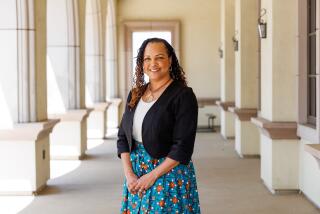Class Links Brain Structure to Pupil Behavior
- Share via
An odd mixture of smells--formaldehyde, cookies and coffee--filled the air as Phillip DeFina held up a gray, fist-sized lump in front of his class.
“Our arousal states emanate from the pons and the brain stem,” the school psychologist said, motioning his students to examine similar lumps--sheep’s brains--in the metal trays in front of them.
The students poked at the rubbery masses with intense curiosity, some carefully peeling away the outer, cellophane-like membranes with forceps.
“We’re not just dissecting a brain here,” DeFina said. “We’re learning the function of the brain to determine the cause of behavioral issues.”
In hopes of probing the mysteries of the mind, about 30 school psychologists from Los Angeles and Orange counties have left their campuses and the students they counsel to become students themselves.
At the Los Angeles County Office of Education headquarters in Downey, the psychologists recently attended a two-week introductory class for a yearlong course in neuropsychology: the science of linking the brain’s structure and function to behavior.
Many of the psychologists said the post-graduate training, which began July 8, would help them place disabled children with traumatic brain injuries, autism and other learning disabilities on the correct special education plans.
School psychologists often use IQ and achievement tests to determine disabilities, but it is difficult to define the exact nature of a child’s learning problem, DeFina said.
“It’s a shotgun approach that takes a long time,” he said. “Neuropsychologists use a more finely tuned approach by determining the emotional and behavioral blueprint of a child.”
Nancy Zuckerman Goldstein, a school psychologist in South Pasadena Unified School District, said she had enrolled in the program to gain a deeper understanding of what she had learned as a psychologist.
“We’re trained to find out what is wrong” with a child, she said. “But neuropsychologists can explain more about why a certain part of the brain affects that particular function. It’s a step deeper.”
While updating the psychologists on the latest neuroscience breakthroughs, the program also teaches them about brain chemistry and environmental stress.
“With the proper training, we could use what we know to diagnose kids, perhaps avoiding incidents of school violence like Columbine,” said Sandy Elson, a school psychologist who works for Los Angeles County.
The training is intended to help not only the child, but also the classroom teachers, who will “have more information related to a child’s strengths and weaknesses,” said Dan Miller, chairman of the psychology and philosophy department at Texas Women’s University in Denton, which is sponsoring the program.
For example, with a psychologist’s help, the teacher might learn whether a child works better with visual cues than with numbers. A child may register the spelling of a word by looking at the arrangement of letters on paper, but not comprehend it aurally. A teacher could then use flashcards to teach that student.
In such a case, it might not be wise to judge a student’s intelligence solely on the results of an IQ test, said Miller, who founded the program.
After showing the class a video in which a scientist dissected a human brain, DeFina hit the pause button. “What you learn here will help you guys be the bridge between teachers, educators and the medical doctors who are writing all the prescriptions for these kids,” he said.
School psychologists and neuropsychologists use many of the same assessment measures, such as statistical models, classroom behavior observation and academic tests. Both use oral question-and-answer sessions, written exams and physical tasks to measure, for example, motor skills.
While neuropsychologists don’t use medical technology, such as CAT scans, they do have a few more tools than psychologists. They run other noninvasive exams for such brain functions as memory, abstract reasoning and attention. Those might lead to diagnoses and treatment plans different from those psychologists would devise, Miller said.
Neuropsychologists began training school psychologists in the 1990s after a federal initiative helped biomedical research in this area, DeFina said.
In 1990, a federal law identified traumatic brain injury as a “handicapping condition” to be accommodated in the schools. At the same time, shrinking private practices, combined with the rise of health maintenance organizations, have made it more difficult for children with such disabilities to receive medical services, Miller said.
“We have children who suffered brain injuries ... and they show up on the doorstep of schools saying, ‘Here I am, educate me,’ ” Miller said. “The psychologists aren’t prepared to deal with them.”
To enroll in the neuropsychology program, students must be licensed school psychologists with at least three years of on-the-job experience. They pay $3,000 apiece for the course. Some school districts pay the tuition. Districts do not necessarily increase salaries with this certification.
After the two-week summer session, the class participates in online discussions and quizzes. It is to meet every Saturday during the school year. The course is to conclude with a weeklong session at the end of the year; the psychologists must pass a three-hour multiple-choice exam to receive certificates from Texas Women’s University.
There are about 1,000 school psychologists in Los Angeles County, 300 in Orange County and more than 4,000 statewide. DeFina hopes to train enough so that there will be at least one certified psychologist in every district. Miller plans to expand the program to other U.S. cities.
Many school psychologists in the program think it will improve their services to the combined 124,000 students with learning disabilities in Los Angeles and Orange counties.
Elizabeth Springer, a full-time psychologist in the Inglewood Unified School District, said parents are interested in learning more than that their children are not functioning well in school.
“They want to know the cause,” she said. “But they also want a way to prevent it, so that their child can move on to being treated.”
More to Read
Sign up for Essential California
The most important California stories and recommendations in your inbox every morning.
You may occasionally receive promotional content from the Los Angeles Times.










